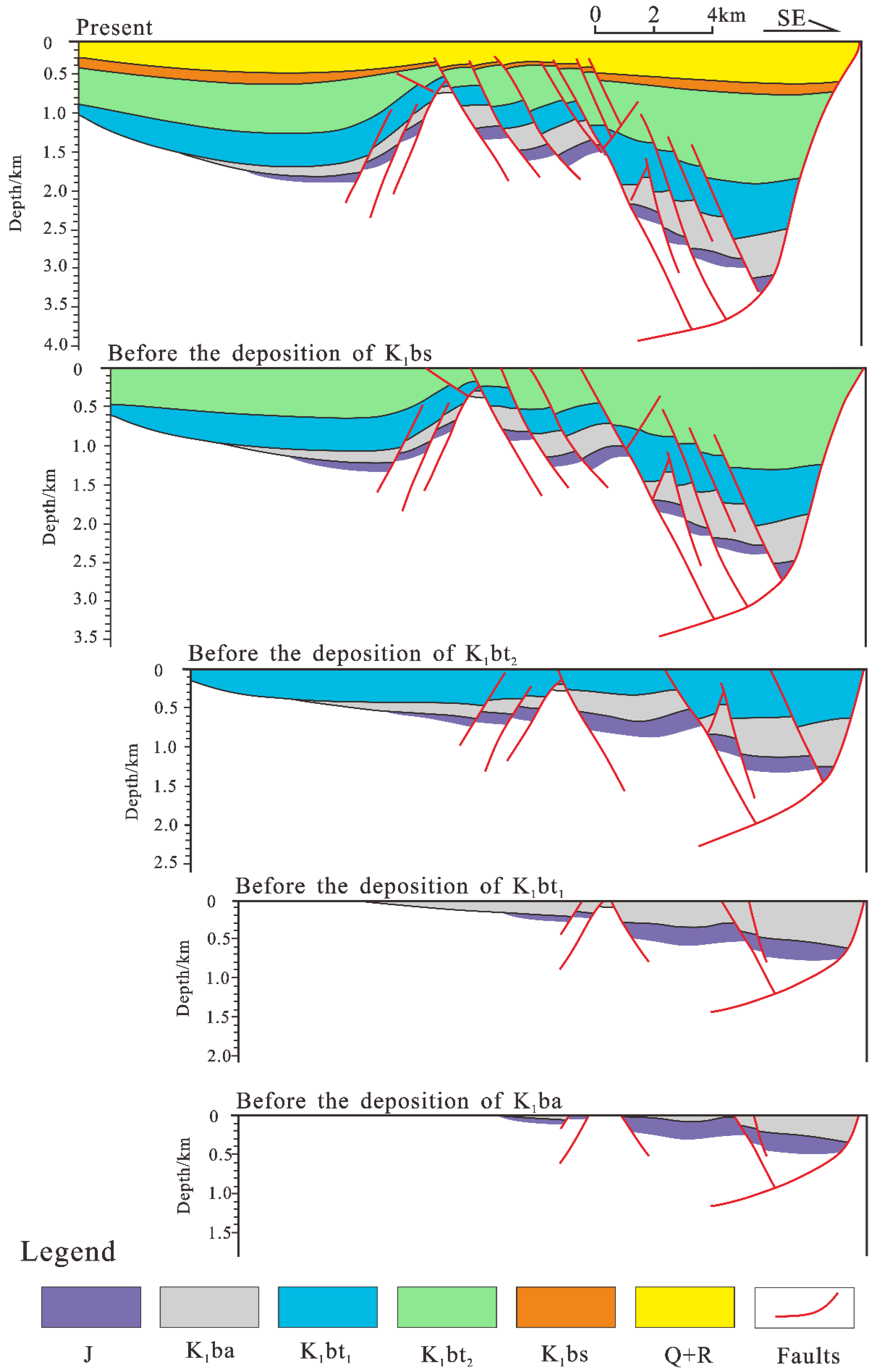Sedimentary Characteristics and Their Controlling Factors of Lower Cretaceous Fan Deltas in Saidong Sub-Sag of Saihantala Sag, Erlian Basin, Northeastern China
Abstract
1. Introduction
2. Geological Setting
3. Data and Methods
3.1. Data
3.2. Methods
4. Results
4.1. Sedimentary Characteristics
4.1.1. Lithofacies Analysis and Interpretation
- Conglomerate lithofacies
- 2.
- Sandstone lithofacies
- 3.
- Mudstone lithofacies
4.1.2. Detrital Component
4.1.3. Grain Size Analysis
- Type I: single-stage (Supplementary Figure S3a) and multi-stage (Supplementary Figure S3b).
- 2.
- Type II: three-stage (Supplementary Figure S3c).
- 3.
- Type III: two-stage (Supplementary Figure S3d).
4.1.4. Analysis of Sedimentary Facies Characteristics
- Fan delta plain subfacies
- (1)
- Braided river channel. It is the most developed microfacies in the fan delta plain subfacies and is usually formed in the late flood period [75,76]. A great number of clastic sediments are transported by debris flow and traction flow. The lithology is mainly composed of pebble conglomerate, with a small amount of arenaceous argillaceous sediments, poor gravel sorting and grinding, and higher content of the fine-silty matrix. Additionally, gravel is supported by the matrix and manifested by the micro-dentate box-shaped logging curve.
- (2)
- Debris flow. It is formed by the accumulation of a great number of water bodies mixed with debris along the groove or sector surface of the sector in the early period of the flood [77]. The shape and distribution of debris flow are proportional to the hydrodynamic strength. When the hydrodynamic force is weak, the debris flow may be a band distribution along the groove, otherwise, it is a fan-shaped distribution [66]. The lithology of the debris flow features coarse clastic, mostly pebble conglomerate with arenaceous and argillaceous sediments whose sorting and rounding are poor, most of which are sub-angular and angular, with high hybridity. Moreover, the debris particles are disorderly arranged, with a high content of the argillaceous and silty matrix, leading to poor reservoir capability. By and large, the overall responses of logging curves tend to be straight with high gamma and resistivity.
- (3)
- Sheetflood zone. It is formed when the debris sediments were carried by floods which spilled over the braided river channel, due to the continuous erosion and transformation of the braided river channel. Its distribution is unstable and easily mixed with the sandbody of the braided river channel [75,76]. The lithology comprises pebble-granule conglomerate with argillaceous sediments, commonly observed through cross bedding, block bedding, parallel bedding, etc. On logging curves, the sheet flood zone deposits are featured by dentate-like box-shaped GR responses.
- (4)
- Inter-fan belt. It is mainly distributed on both sides of the fan delta plain subfacies, formed by the deposition of fine debris carried by fan water flows (floodwater or fan rain) or wind [78], which is home to fine-grained clastics such as brown mudstone, silty mudstone, and silty-fine sandstone with small monolayer-thickness mudstone. On logging curves, the inter-fan belt deposits have slightly flat-straight GR responses.
- 2.
- Fan delta front subfacies
- (1)
- Subaqueous distributary channel. It is the most developed microfacies of fan delta front subfacies, which is formed by the slump of the fan delta front sandbody in the steep slope, whose lithology is mostly gray pebbled sandstone and medium-grained sandstone with poor mudstone. Single-stage channel sand bodies were mostly in positive rhythms. From bottom to top, they often show normal grain order from pebble conglomerate to pebbled sandstone and sandstone, and composite rhythms are rarely found [67]. The scour surface usually appeared in the bottom with large cross bedding and parallel bedding, with bell-shaped or box-shaped responses in logging curves.
- (2)
- Inter-distributary channel. It is mainly characterized by gray-green silty mudstone, argillaceous siltstone, and siltstone with small thickness layers. It has strong biological disturbance, thus conchostracan fossils and plant debris fossils can be found there [67]. The inter-distributary channel is responded to by a jagged GR response, which is formed by the underwater extension of the braided channel in the fan delta plain.
- (3)
- Mouth bar. It is mainly developed at the estuary of the subaqueous distributary channel and is the accumulation of sand bodies after rushing out of the channel, usually extending to the center of the lake basin, with a relatively small deposition range and scale [80]. The lithology mostly comprises siltstone, argillaceous siltstone, and mudstone, showing the reverse rhythm of fine and coarse sandstone, with a high composition maturity and better sorting. Additionally, the wavy bedding is common to find, and the logging response is medium dentate funnel-shaped [81] (Supplementary Figure S7).
- (4)
- Sand sheet. It is a fine-grained sand body with better sorting after being washed, sieved, and migrated by lake water [80], which is characterized by interbedded sandstone and mudstone, with thin and wide single layers. Thus, it resulted from weak hydrodynamic forces, and usually developed wavy bedding, with a dentate-shaped GR response (Supplementary Figure S7).
- 3.
- Prodelta subfacies
4.2. Sedimentary Facies Evolution and Their Planar Distributions
5. Discussion
5.1. Paleoclimate
5.1.1. Rock Color Differentiation
5.1.2. Fossils
5.2. Tectonic Constraints
5.3. Sedimentary Model
6. Conclusions
- (1)
- The Lower Cretaceous fan deltas in the Saidong sub-sag can be divided into 3 categories, 12 sub-categories, and 20 fine lithofacies types. From the lithofacies characteristics, genetic mechanism, and distribution of different lithofacies, the proportion of fan delta traction flow in the study area is higher than gravity flow.
- (2)
- The Lower Cretaceous fan deltas in the Saidong sub-sag of the Saihantala sag mainly developed three subfacies, namely fan delta plain, fan delta front, and prodelta, and can be further subdivided into eight microfacies, including braided river channel, subaqueous distributary channel, inter-distributary channel, mouth bar, and sand sheet, with the braided river channels and subaqueous distributary channels as the major microfacies. Based on the vertical evolution of the sedimentary and lithofacies characteristics of each microfacies at the sand body, we believe that the A’ershan Formation to Tengge’er Formation in the Saidong sub-sag mainly experienced three stages: the water transgression period, the water oscillation period, and the water regression period. Each stage has different sedimentary evolution features.
- (3)
- The fan delta deposits in the Saidong sub-sag are mainly controlled by a semi-arid to hygrothermal to semi-arid paleoclimate as well as paleotectonic activity. The fan delta sedimentary pattern of the Saidong sub-sag in the Saihantala sag established in this study can improve the differentiation and classification of the fan delta sedimentary characteristics in other potential areas of the Erlian Basin.
Supplementary Materials
Author Contributions
Funding
Institutional Review Board Statement
Informed Consent Statement
Data Availability Statement
Acknowledgments
Conflicts of Interest
References
- Colella, A. Fault-controlled marine Gilbert-type fan deltas. Geology 1988, 16, 1031–1034. [Google Scholar] [CrossRef]
- Postma, G.; Colella, A.; David, B.P. Depositional architecture and facies of river and fan deltas: A synthesis. Coarse Grained Deltas 1990, 10, 13–27. [Google Scholar]
- Gupta, S.; Underhill, J.R.; Sharp, I.R.; Gawthorpe, R.L. Role of fault interactions in controlling synrift sediment dispersal patterns: Miocene, Abu Alaqa Group, Suez Rift, Sinai, Egypt. Basin Res. 1999, 11, 167–189. [Google Scholar]
- Breda, A.; Mellere, D.; Massari, F.; Asioli, A. Vertically stacked Gilbert-type deltas of Ventimiglia (NW Italy): The Pliocene record of an overfilled Messinian incised valley. Sediment. Geol. 2009, 219, 58–76. [Google Scholar] [CrossRef]
- Gobo, K.; Ghinassi, M.; Nemec, W. Reciprocal changes in foreset to bottomset facies in a Gilbert-type delta: Response to short-term changes in base level. J. Sediment. Res. 2014, 84, 1079–1095. [Google Scholar] [CrossRef]
- Gobo, K.; Ghinassi, M.; Nemec, W.; Sjursen, E. Development of an incised valley-fill at an evolving rift margin: Pleistocene eustasy and tectonics on the southern side of the Gulf of Corinth, Greece. Sedimentology 2014, 61, 1086–1119. [Google Scholar] [CrossRef]
- Gobo, K.; Ghinassi, M.; Nemec, W.; Walsh, J.P. Gilbert-type deltas recording short-term base-level changes: Delta-brink morphodynamics and related foreset facies. Sedimentology 2015, 62, 1923–1949. [Google Scholar] [CrossRef]
- Martini, I.; Ambrosetti, E.; Sandrelli, F. The role of sediment supply in large-scale stratigraphic architecture of ancient Gilbert-type deltas (Pliocene Siena-Radicofani Basin, Italy). Sediment. Geol. 2017, 350, 23–41. [Google Scholar]
- Yu, H.T.; Liu, X.Y.; Wu, B.W.; Liu, X.M. Large Fan Delta Control Factors of Upper Wuerhe Formation of Shawan Sag in Northwest Margin of Junggar Basin. Xinjiang Geol. 2020, 38, 71–76. [Google Scholar]
- Zhang, C.; Yu, X.H.; Yao, Z.Q.; Li, L.S.; Shan, X.; Xiang, M.; Li, Y.L. Sedimentary evolution and controlling factors of the Middle-Upper Jurassic in the western part of the southern Junggar Basin. Geol. China 2021, 1, 284–296. [Google Scholar]
- Yue, J.H.; Huang, C.Y.; Cao, L.Z.; Wang, H.X.; Zheng, R.H.; Wu, J.P.; Xiang, X.; Liu, H. Sedimentary characteristics and controlling factors of the Ba 66 Fan in Bayindulan Sag. Bull. Geol. Sci. Technol. 2021, 40, 88–98. [Google Scholar]
- Winsemann, J.; Lang, J.; Polom, U.; Loewer, M.; Igel, J.; Pollok, L.; Brandes, C. Ice-marginal forced regressive deltas in glacial lake basins: Geomorphology, facies variability and large-scale depositional architecture. Boreas 2018, 47, 973–1002. [Google Scholar] [CrossRef]
- Winsemann, J.; Lang, J.; Fedele, J.J.; Zavala, C.; Hoyal, D.C.J.D. Re-examining models of shallow-water deltas: Insights from tank experiments and field examples. Sediment. Geol. 2021, 421, 105962. [Google Scholar] [CrossRef]
- Zhao, G.L.; Zhao, C.L.; Ye, L.J. Sedimentary System of “Four Fans and One Channel” In the Bohai Gulf Basin and Its Significance for Petroleum Exploration. J. Geomech. 2005, 3, 245–258. [Google Scholar]
- Liang, H.B.; Cui, Z.Q.; Dong, X.Y.; Li, H.E.; Si, J.W.; Wang, Y.J. Characteristics of Highstand Delta System and Play in Gentle Slop of Faulted Lacustrine Basin: A Case Study of Jiergalangtu Sag, Erlian Basin. Acta Sedimentol. Sin. 2011, 29, 783–792. [Google Scholar]
- Liang, G.Z.; Tan, J.C.; Wei, L.; Jiang, Y.; Cao, W.; Wu, W.L.; Guo, X.G. Sedimentary characteristics of nearshore subaqueous fans of the Lower Cretaceous in Abei sag of Erlian Basin, Inner Mongolia. J. Palaeogeogr. 2013, 15, 31–42. [Google Scholar]
- Song, G.Q.; Hao, X.F.; Liu, K.Q. Tectonic evolution, sedimentary system and petroleum distribution patterns in dustpan-shaped rift basin: A case study from Jiyang Depression, Bohai Bay Basin. Oil Gas Geol. 2014, 35, 303–310. [Google Scholar]
- Gawthorpe, R.L.; Leeder, M.R. Tectono-sedimentary evolution of active extensional basins. Basin Res. 2000, 12, 195–218. [Google Scholar] [CrossRef]
- Kim, W.; Paola, C. Long-period cyclic sedimentation with constant tectonic forcing in an experimental relay ramp. Geology 2007, 35, 331–334. [Google Scholar] [CrossRef]
- Yu, X.H.; Jiang, H.; Li, S.L.; Chen, Y.Q. Depositional filling models and controlling factors on Mesozoic and Cenozic fault basins of terrestrial facies in eastern China: A case study of Dongying Sag of Jiyang Depression. Lithol. Reserv. 2007, 19, 39–45. [Google Scholar]
- Henstra, G.A.; Gawthorpe, R.L.; Helland-Hansen, W.; Ravnås, R.; Rotevatn, A. Depositional systems in multiphase rifts: Seismic case study from the Lofoten margin, Norway. Basin Res. 2017, 29, 447–469. [Google Scholar] [CrossRef]
- Shanley, K.W.; McCabe, P.J. Perspectives on the sequence stratigraphy of Continental strata. AAPG Bull. 1994, 78, 544–568. [Google Scholar]
- Jackson, C.A.L.; Gawthorpe, R.L.; Carr, I.D.; Sharp, I.R. Normal faulting as a control on the stratigraphic development of shallow marine syn-rift sequences: The Nukhul and Lower Rudeis Formations, Hammam Faraun fault block, Suez Rift, Egypt. Sedimentology 2005, 52, 313–338. [Google Scholar] [CrossRef]
- Hsiao, L.-Y.; Graham, S.A.; Tilander, N. Stratigraphy and sedimentation in a rift basin modified by synchronous strike-slip deformation: Southern Xialiao basin, Bohai, offshore China. Basin Res. 2010, 22, 61–78. [Google Scholar] [CrossRef]
- Jiang, S.; Henriksen, S.; Wang, H.; Lu, Y.C.; Ren, J.Y.; Cai, D.S.; Feng, Y.L.; Weimer, P. Sequence-stratigraphic architecture and sand-body distribution in Cenozoic rifted lacustrine basins, east China. AAPG Bull. 2013, 97, 1447–1475. [Google Scholar] [CrossRef]
- Jia, Y.C.; Lin, C.S.; Eriksson, K.A.; Niu, C.M.; Li, H.Y.; Zhang, P. Fault control on depositional systems and sequence stratigraphic architecture in a multiphase, rifted, lacustrine basin: A case study from the paleogene of the central Bohai Bay Basin, northeast China. Mar. Pet. Geol. 2018, 101, 459–475. [Google Scholar] [CrossRef]
- Carroll, A.R.; Bohacs, K.M. Stratigraphic classification of ancient lakes: Balancing tectonic and climatic controls. Geology 1999, 27, 99–102. [Google Scholar] [CrossRef]
- Lin, C.S.; Kenneth, E.; Li, S.T. Sequence architecture, depositional systems, and controls on development of lacustrine basin fills in part of the Erlian basin, northeast China. AAPG Bull. 2001, 55, 2017–2043. [Google Scholar]
- Wu, C.Y.; Xue, S.H. Sedimentology of Petroliferous Basins in China; Petroleum Industry Press: Beijing, China, 1993; pp. 38–42. [Google Scholar]
- Xie, X.N.; Sun, Y.C.; Deng, X.H.; Ding, Z.Y.; Han, G.L. Patterns of fan delta sequence and their controlled parameters. Earth Sci. 1993, 6, 749–756. [Google Scholar]
- Xue, L.Q.; Galloway, W.E. Fan-Delta, Braid Delta And The Classification Of Delta Systems. Acta Geol. Sin. 1991, 65, 141–153. [Google Scholar]
- Gómez-Paccard, M.; López-Blanco, M.; Costa, E.; Garcés, M.; Beamud, E.; Larrasoaña, J.C. Tectonic and climatic controls on the sequential arrangement of an alluvial fan/fan-delta complex (Montserrat, Eocene, Ebro Basin, NE Spain). Basin Res. 2012, 24, 437–455. [Google Scholar] [CrossRef]
- Li, Y.X. Early Oligocene fan-deltas in Liaohe rift. Pet. Explor. Dev. 1982, 4, 21–27. [Google Scholar]
- Gu, J.Y. Sedimientation of ancient fan-deltas in eastern China. Oil Gas Geol. 1984, 3, 236–245. [Google Scholar]
- Nemec, W.; Steel, R.J.; Yao, G.Q. Fan Delta and Its Identification. J. Gems Gemmol. 1999, 1, 40–47. [Google Scholar]
- Wang, H.J.; Cao, W.F. Lacustrine-deltaic deposits of Cretaceous in Song Liao basin. Pet. Geol. Oilfield Dev. Daqing 1983, 2, 15–24. [Google Scholar]
- Einar, A.; Roy, H.G.; Eduardo, R. The significance of the fracture pattern of the Late-Eocene Montserrat fan-delta, Catalan Coastal Ranges (NE Spain). Tectonophysics 1996, 266, 465–491. [Google Scholar]
- Mu, L.X.; Jia, A.L. Reservoir Models and Prediction Method for Fan-delta; Petroleum Industry Press: Beijing, China, 2000; pp. 19–91. [Google Scholar]
- Wang, S.Q. Sedimentary facies and model of Shuanghe fan delta. Xinjiang Pet. Geol. 1986, 3, 26–34. [Google Scholar]
- Sohn, Y.K. Coarse-grained debris-bow deposits in the Miocene fan-deltas, SE Korea: A scaling analysis. Sediment. Geol. 2000, 130, 45–64. [Google Scholar] [CrossRef]
- Richard, G.H.; Kenneth, D.R. Sedimentology and sequence stratigraphy of fan-delta and river-deltadeposystems, Pennsylvanian Minturn Formation, Colorado. AAPG Bull. 2003, 87, 1169–1191. [Google Scholar]
- McConnico, T.S.; Bassett, K.N. Gravelly Gilbert-type fan delta on the Conway Coast, New Zealand: Foreset depositional processes clast imbrication. Sediment. Geol. 2007, 198, 147–166. [Google Scholar] [CrossRef]
- Yu, X.H.; Qu, J.H.; Tan, C.P.; Zhang, L.; Li, X.L.; Gao, Z.P. Conglomerate Lithofacies and Origin Models of Fan Deltas of Baikouquan Formation in Mahu Sag, Junggar Basin. Xinjiang Pet. Geol. 2014, 35, 619–627. [Google Scholar]
- Wang, X.J.; Li, W.F.; Dong, H.; Zhu, J.; Zhang, D.Y.; Yin, S.J. Genetic Classification of Sandy Conglomerate lithofacies and Sedimentary Characteristics of Fan Delta: A Case Study from Upper Wuerhe Formation in District Wuba in Northwestern Margin of Junggar Basin. Xinjiang Pet. Geol. 2017, 5, 537–543. [Google Scholar]
- Zhang, J.L.; Wang, B.Q. Facies Models For Lacustrine Fan Deltas In Hydrocarbon-Bearing Basins, China. Geol. Rev. 1996, 42, 147–152. [Google Scholar]
- Zhang, C.S.; Liu, Z.B.; Shi, D.; Jia, A.L. Formed Proceeding and Evolution Disciplinarian of Fan Delta. Acta Geol. Sin. 2000, 18, 521–525. [Google Scholar]
- Cheng, L.H.; Chen, S.Y.; Wu, S.H.; Yan, J.H.; Jiang, Z.X.; Wang, J.W.; Liu, Y.L. The Simulation And Sedimentary Dynamic Analysis Of Fan Delta In The Steep Slope Of Fault Basin. Mar. Geol. Quat. Geol. 2005, 25, 29–34. [Google Scholar]
- Pang, J.G.; Yang, Y.Y.; Pu, X.G. Identification characteristics of fan delta, nearshore submarine fan, and sublacustrine fan in fault trough lake basin. J. Lanzhou Univ. (Nat. Sci.) 2011, 47, 18–23. [Google Scholar]
- Ji, Y.L.; Lu, H.; Liu, Y.R. Sedimentary model of shallow water delta and beach bar in the Member 1 of Paleogene Funing Formation in Gaoyou sag, Subei Basin. J. Palaeogeogr. 2013, 15, 729–740. [Google Scholar]
- Cheng, G.; Si, C.S.; Zhang, H.L.; Yan, X.F.; Liu, Y.F. Study on sedimentary numerical simulation method of fan delta sand body. J. Geol. 2013, 37, 178–182. [Google Scholar]
- Zou, Z.W.; Li, H.; Xu, Y.; Yu, C.F.; Meng, X.C. Sedimentary characteristics of the Baikouquan Formation, Lower Triassic in Mahu Depression, Junggar Basin. Bull. Geol. Sci. Technol. 2015, 34, 20–26. [Google Scholar]
- Jiang, Q.P.; Kong, C.X.; Li, W.F.; Qiu, Z.G.; Lu, Z.Y.; Hang, T.Q.; Liu, K.; Chen, D.L.; Li, S.; Yuan, X.G. Sedimentary Characteristics and Evolution Law of a Lacustrine Large-scale Fan Delta: A case study from the Triassic Baikouquan Formation on the west slope of Mahu Sag. Acta Sedimentol. Sin. 2020, 38, 923–932. [Google Scholar]
- Zou, Z.W.; Guo, H.J.; Niu, Z.J.; Xu, Y.; Shan, X.; Li, Y.Z.; Shen, J.L. Sedimentary characteristics and controlling factors of river-dominated fan delta: A case study from Upper Urho Formation in Mahu Sag of Junggar Basin. J. Palaeogeogr. 2021, 23, 756–770. [Google Scholar]
- Zhang, W.C. Sedimentary Feature of Fan Delta in Erlian Basin. Fault-Block Oil Gas Field 1998, 5, 3–5. [Google Scholar]
- Cheng, Y.Q. Sedimentary characteristics study on Lower Cretaceous of Saihantala Sag, Erlian Basin. Master’s Thesis, China University of Geosciences, Beijing, China, 2010. [Google Scholar]
- Zhou, T.Q. Research on the Sedimentary Characteristics of the Glutenite in Lower Cretaceous of the Eastern Sag, Saihantala Depression, Erlian Basin. Master’s Thesis, Northeast Petroleum University, Daqing, China, 2020. [Google Scholar]
- Zhang, Y.M.; Liu, Z.; Fu, S.; Jiang, S.Q.; Yao, N.; Wang, X. New understandings of the basement characteristics and evolution process of Erlian Basin. Oil Geophys. Prospect. 2019, 54, 404–416. [Google Scholar]
- Wu, P. The hydrocarbon accumulation mechanism of typical depression troughs in Erlian Basin. Ph.D. Thesis, China University of Geosciences, Beijing, China, 2020. [Google Scholar]
- Zhao, X.Z.; Wang, Q.; Dan, W.N.; Wang, W.Y.; Qiao, X.X.; Ren, C.L. Exploration discovery and prospects of Cretaceous stratigraphic-lithologic reservoirs in Erlian Basin. Lithol. Reserv. 2017, 29, 1–9. [Google Scholar]
- Li, J.H.; Hou, D.J.; Cao, L.Z.; Wu, P.; Zhao, Z.; Ma, X.X. Geochemical Characteristics and Source Correlation of Low-Mature Oil from the Tengge’er Formation (2nd Member) in the Saihantala Sag, Erlian Basin. Geoscience 2021, 35, 315–325. [Google Scholar]
- Cheng, S.Y.; Liu, S.F.; Su, S.; Ren, J.L. Structural characteristics analysis of Saihantala sag in Erlian Basin. Oil Geophys. Prospect. 2011, 46, 961–969. [Google Scholar]
- Fu, S.; Liu, Z.; Ge, J.W.; Tian, N.; Wang, X.; Wang, H.L.; Liu, H.; Yin, K.W.; Han, Q. Tectono-stratigraphy characteristics of the Lower Cretaceous Saihantala Sag in the Erlian Basin, China: Normal faulting and controls on the depositional variability. J. Pet. Sci. Eng. 2020, 195, 107840. [Google Scholar] [CrossRef]
- Qu, X.Y.; Yang, M.H.; Luo, X.H.; Ding, C.; Zhou, D.; Gong, T.; Yang, G. Extensional Tectonic Feature and Its Control on Hydrocarbon Accumulation of Saihantala Sag in Erlian Basin. Geoscience 2013, 27, 1023–1032. [Google Scholar]
- Zou, C.N.; Zhao, Z.Z.; Yang, H.; Fu, J.H.; Zhu, R.K.; Yuan, X.J.; Wang, L. Genetic Mechanism and Distribution of Sandy Debris Flows in Terrestrial Lacustrine Basin. Acta Sedimentol. Sin. 2009, 27, 1065–1075. [Google Scholar]
- Hart, B.S.; Plint, A.G. Gravelly Shoreface and Beachface Deposits. In Sedimentary Facies Analysis; Plint, A.G., Ed.; Wiley: Oxford, UK, 1995; Volume 22, pp. 75–99. [Google Scholar]
- Massari, F.; Parea, G.C. Progradational gravel beach sequences in a moderate-to high-energy, microtidal marine environment. Sedimentology 1988, 35, 881–913. [Google Scholar] [CrossRef]
- Miall, A.D. A review of the braided-river depositional environment. Earth Sci. Rev. 1977, 13, 1–62. [Google Scholar] [CrossRef]
- Rust, B.R. Pebble Orientation In Fluvial Sediments. J. Sediment. Petrol. 1972, 42, 384–388. [Google Scholar]
- Yang, K.; Zhu, X.M.; Liu, Y.; Liu, X.Z.; Guo, F. Key Signatures of Turbidite and Sandy Debris and Core Examples in Liaohe Basin. J. Palaeogeogr. (Chin. Ed.) 2020, 22, 483–492. [Google Scholar]
- Covault, J.A.; Hubbard, S.M.; Graham, S.A.; Hinsch, R.; Linzer, H.-G. Turbidite-reservoir architecture in complex foredeep-margin and wedge-top depocenters, Tertiary Molasse foreland basin system, Austria. Mar. Pet. Geol. 2008, 26, 379–396. [Google Scholar] [CrossRef]
- Orton, G.J.; Reading, H.G. Variability of Deltaic Processes in Terms of Sediment Supply, With Particular Emphasis on Grain Size. Sedimentology 1992, 40, 475–512. [Google Scholar] [CrossRef]
- Blair, T.C.; McPherson, J.G. Grain-Size and Textural Classification of Coarse Sedimentary Particles. J. Sediment. Res. 1999, 69, 6–19. [Google Scholar] [CrossRef]
- Li, H. Sedimentary Facies and Reservoir Characteristics of the Lower Cretaceous in Northern Area of Saihantala Sag. Master’s Thesis, China University of Petroleum (East China), Qingdao, China, 2011. [Google Scholar]
- Mc Pherson, J.G.; Shanmugam, G.; Moiola, R.J. Fan deltas and braid deltas: Varieties of coarse-grained deltas. Geol. Soc. Am. Bull. 1987, 99, 331–340. [Google Scholar] [CrossRef]
- Hein, F.J.; Walker, R.G. Bar evolution and development of stratification in the gravelly, braided, Kicking Horse River, British Columbia. Can. J. Earth Sci. 1977, 14, 562–570. [Google Scholar] [CrossRef]
- Miall, A.D. Lithofacies Types and Vertical Profile Models in Braided River Deposits: A Summary. In Fluvial Sedimentology; Miall, A.D., Ed.; Canadian Society of Petroleum Geologists: Calgary, AB, Canada, 1978; Volume 5, pp. 597–604. [Google Scholar]
- Colella, A.; De Boer, P.L.; Nio, S.D. Sedimentology of A Marine Intermountain Pleistocene Gilbert-Type Fan-Delta Complex in The Crati Basin, Calabria, Southern Italy. Sedimentology 1987, 34, 721–736. [Google Scholar] [CrossRef]
- Miall, A.D. Architectural-Element Analysis: A New Method of Facies Applied to Fluvial Deposits. Earth Sci. Rev. 1985, 22, 261–308. [Google Scholar] [CrossRef]
- Yu, Z.; Chen, S.; Xie, W.; Zhao, S.e.; Ma, J.; Gong, T. Implication Linkage among Microfacies, Diagenesis, and Reservoir Properties of Sandstones: A Case Study of Dongying Formation, Nanpu Sag, Bohai Bay Basin. Energies 2022, 15, 7751. [Google Scholar] [CrossRef]
- Schwartz, K.S. Bedform and Stratification Characteristic of Some Modern Small-Scale Washover Sand Bodies. Sedimentology 1982, 29, 835–849. [Google Scholar] [CrossRef]
- Liu, E.; Deng, Y.; Lin, X.; Yan, D.; Chen, S.; Shi, X. Cenozoic Depositional Evolution and Stratal Patterns in the Western Pearl River Mouth Basin, South China Sea: Implications for Hydrocarbon Exploration. Energies 2022, 15, 8050. [Google Scholar] [CrossRef]
- Ward, L.G.; Ashley, G.M. Introduction: Coastal lagoonal systems. Mar. Geol. 1989, 88, 181–185. [Google Scholar] [CrossRef]
- Fawad, N.; Liu, T.; Fan, D.; Ahmad, Q.A. Sedimentary Facies Analysis of the Third Eocene Member of Shahejie Formation in the Bonan Sag of Bohai Bay Basin (China): Implications for Facies Heterogeneities in Sandstone Reservoirs. Energies 2022, 15, 6168. [Google Scholar] [CrossRef]
- Zhao, Z.G.; Wang, F.Y.; Wang, H.B.; Wang, M.W.; Wang, H.; Lan, B.F. Source Kitchen and Organic Facies of Source Rocks in Saihantala Sag, Erlian Basin. Lithol. Reserv. 2017, 29, 28–35. [Google Scholar]
- Maddy, D. An evaluation of climate, crustal movement and base level controls on the Middle-Late Pleistocene development of the River Severn, U.K. Neth. J. Geosci.-Geol. Mijnb. 2016, 81, 329–338. [Google Scholar] [CrossRef]
- Yao, Z.Q.; Yu, X.H.; Shan, X.; Li, S.L.; Li, S.L.; Li, Y.L.; Tan, C.P.; Chen, H.L. Braided–meandering system evolution in the rock record: Implications for climate control on the Middle–Upper Jurassic in the southern Junggar Basin, north-west China. Geol. J. 2018, 53, 2710–2731. [Google Scholar] [CrossRef]
- Ye, L.; Zhu, X.M.; Qin, Y.; Zhu, M. Depositional System of Shallow Water Delta in Rifted Lacustrine Basin. J. Earth Sci. Environ. 2018, 40, 186–202. [Google Scholar]
- Jiang, Z.K.; Wang, Y.X.; Mao, Y.Q.; Zang, K.; Sun, W.; Liu, T.J. The relationship between paleoclimate change and paleosedimentary environment identification in coastal areas. Arab. J. Geosci. 2021, 14, 570. [Google Scholar] [CrossRef]
- Fu, S.; Liu, Z.; Zhang, Y.M.; Wang, X.; Tian, N.; Yao, N.; Xiong, Y.; Chen, P.; Li, L.; Wang, H.L. Depositional systems and sequence stratigraphy of mesozoic lacustrine rift basins in NE China: A case study of the Wulan-Hua sag in the southern Erlian Basin. J. Asian Earth Sci. 2019, 174, 68–98. [Google Scholar] [CrossRef]
- Mao, G.Z. Meso-Cenozoic Paleoclimate Evolution of Erlian Basin. Energy Res. Manag. 2015, 4, 92–96. [Google Scholar]
- Tao, M.H.; Cui, Z.Q.; Chen, G.Q. Mesozoic Sporo-Pollen Assemblages and Climate Fluctuations in Northeast China. Acta Micropalaeontol. Sin. 2013, 30, 275–287. [Google Scholar]
- Zhong, X.; Sun, X.C.; Gu, P.Y.; Li, X.Q.; Liu, S.; Liu, Y. Discovery and Paleoecological and Paleoenvironmental Environment of the Conchostracans from the Cretaceous Xiagou Formation in Zhangye National Geopark. Acta Geosci. Sin. 2020, 41, 543–553. [Google Scholar]
- Meng, Q.R.; Hu, J.M.; Jin, J.Q.; Zhang, Y.; Xu, D.F. Tectonics of the late Mesozoic wide extensional basin system in the China–Mongolia border region. Basin Res. 2003, 15, 397–415. [Google Scholar] [CrossRef]
- Wang, Y.Z. Coupling relationship of Mesozoic-Cenozoic Basin and Mountains in the Erlian Basin. Spec. Oil Gas Reserv. 2011, 18, 60–63, 138. [Google Scholar]
- Xia, S.Q.; Lin, C.S.; Du, X.F.; Li, J.Q.; Li, H. Control of the Syndepositional Fault on Depositional Fillings of the Dongying Formation in Northern Liaodong Bay. J. Southwest Pet. Univ. (Sci. Technol. Ed.) 2020, 42, 19–32. [Google Scholar]
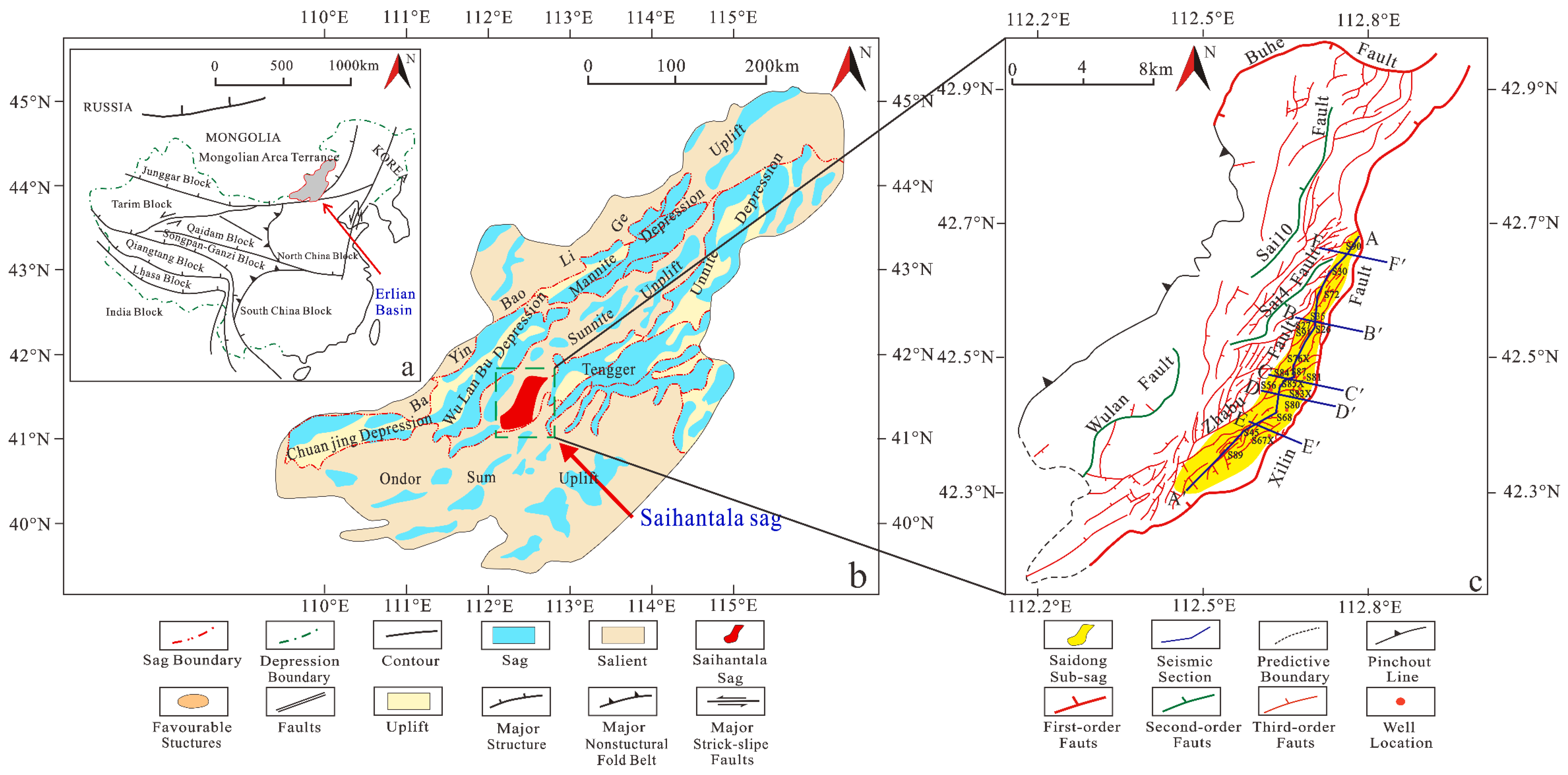
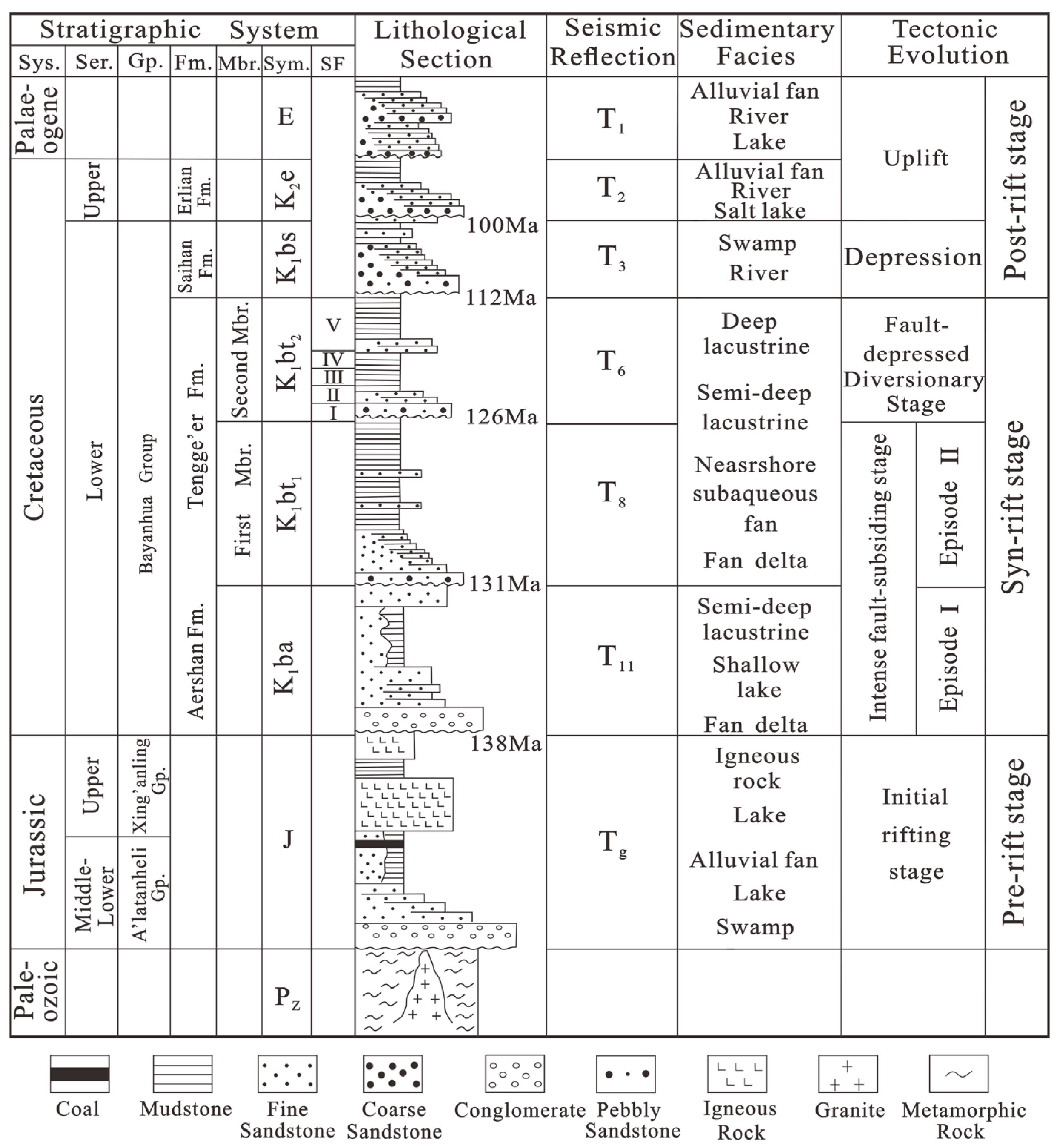
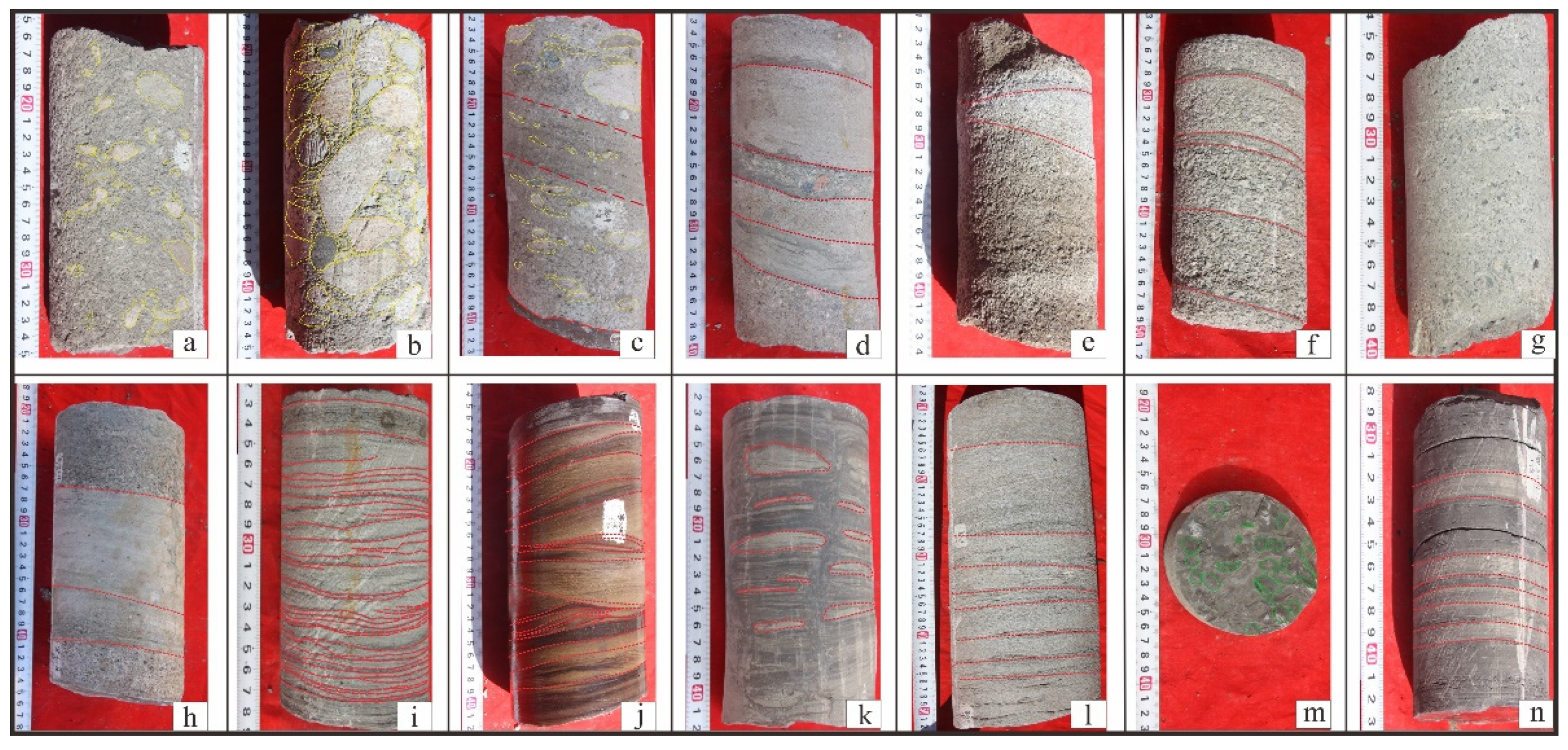
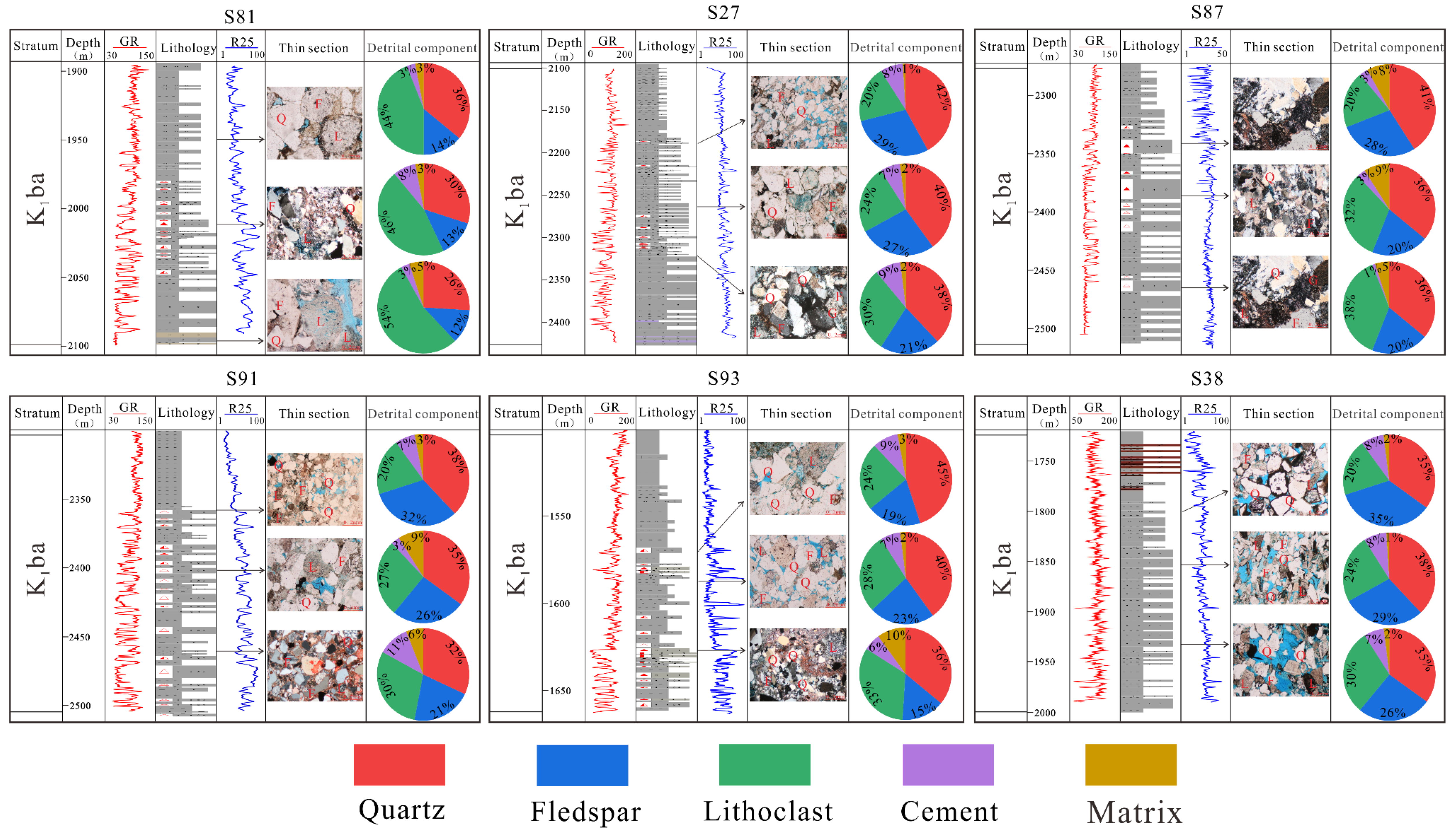
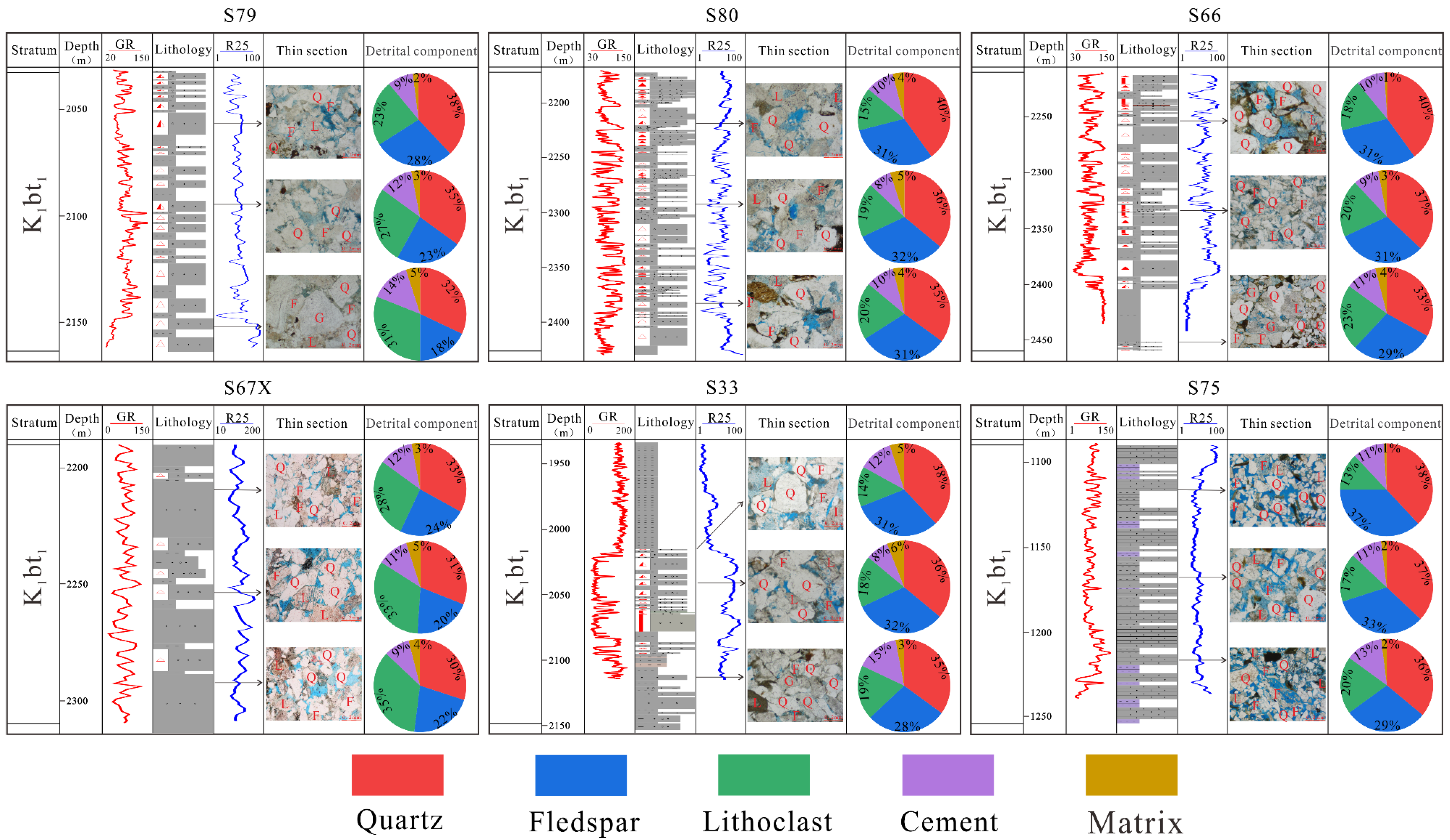
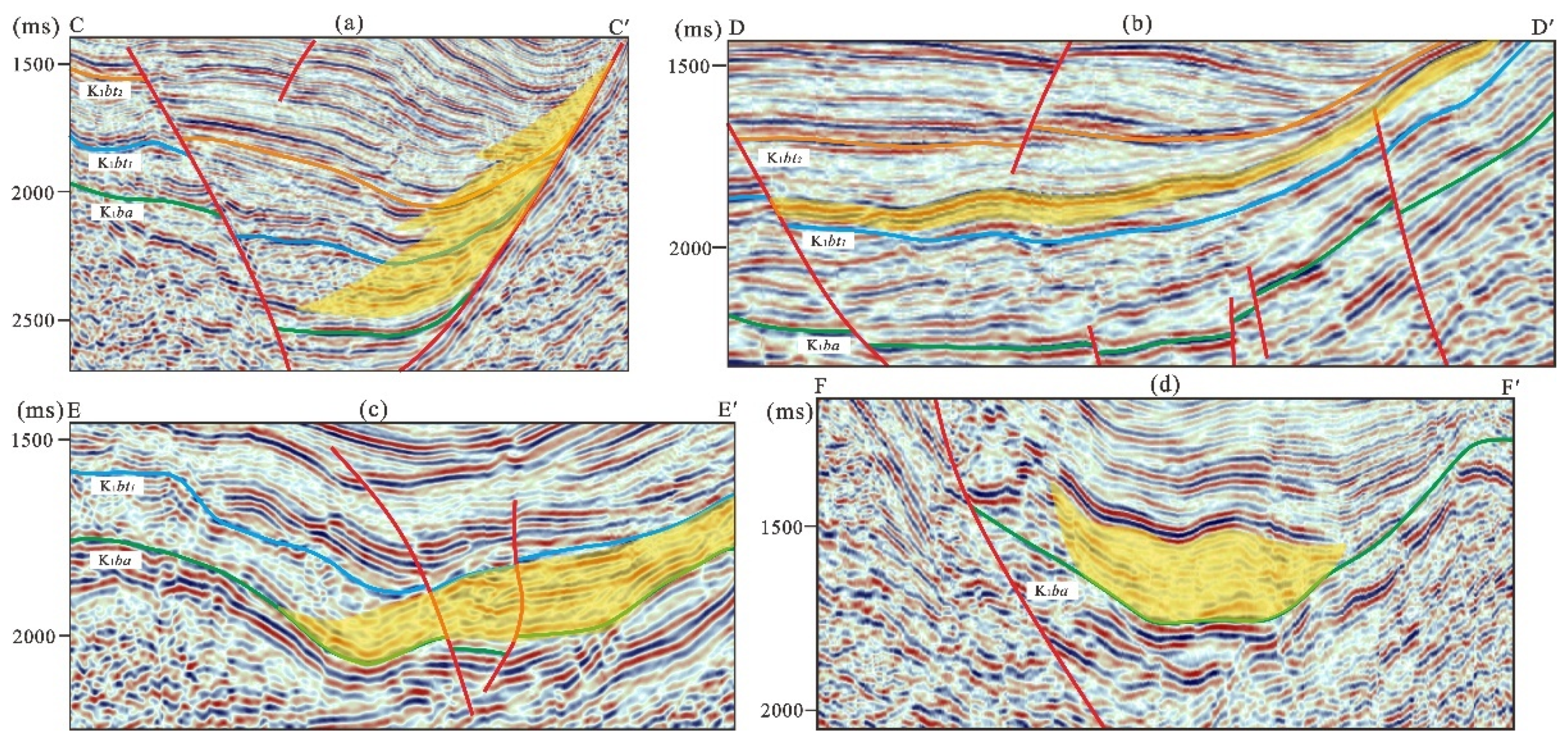
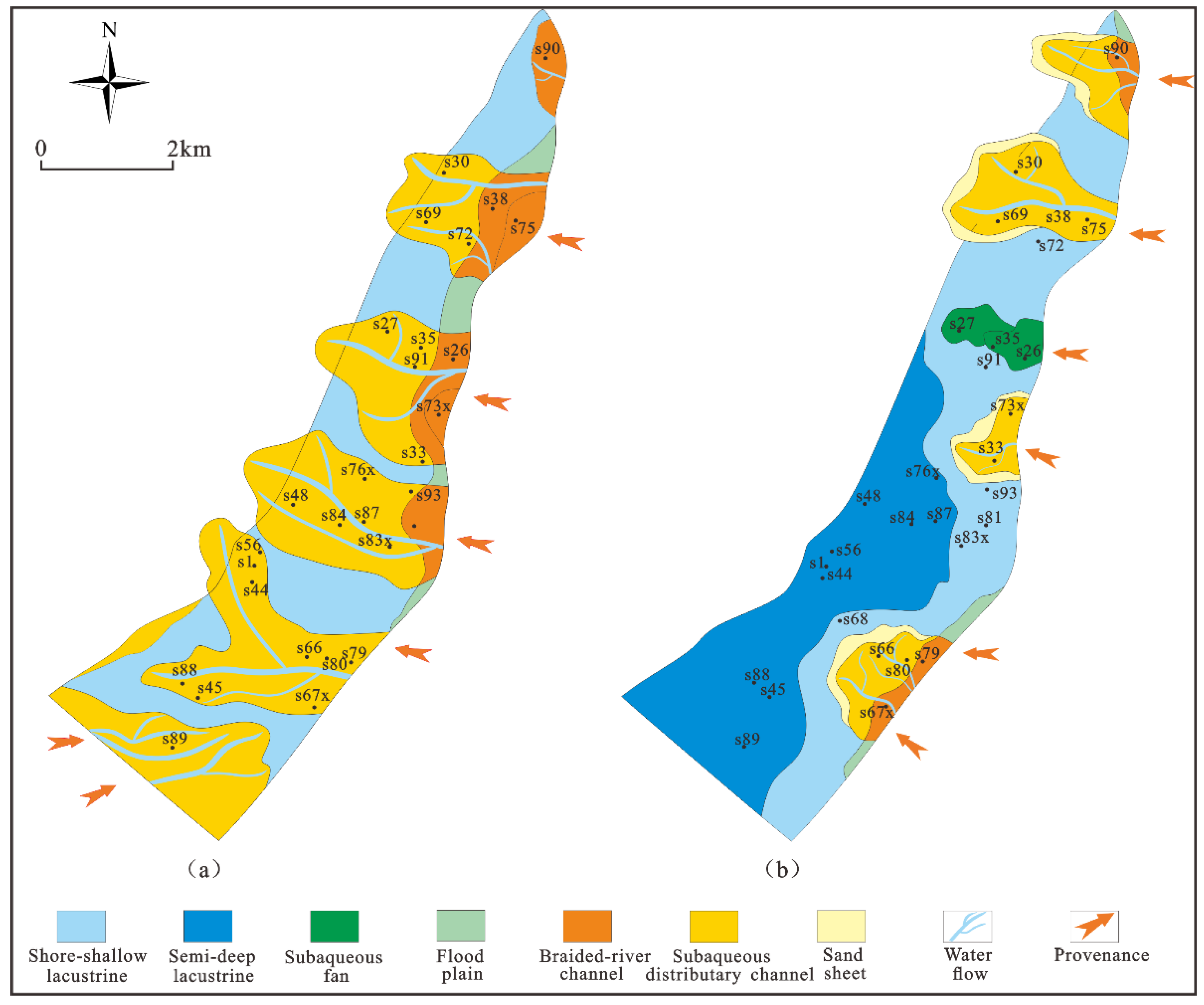
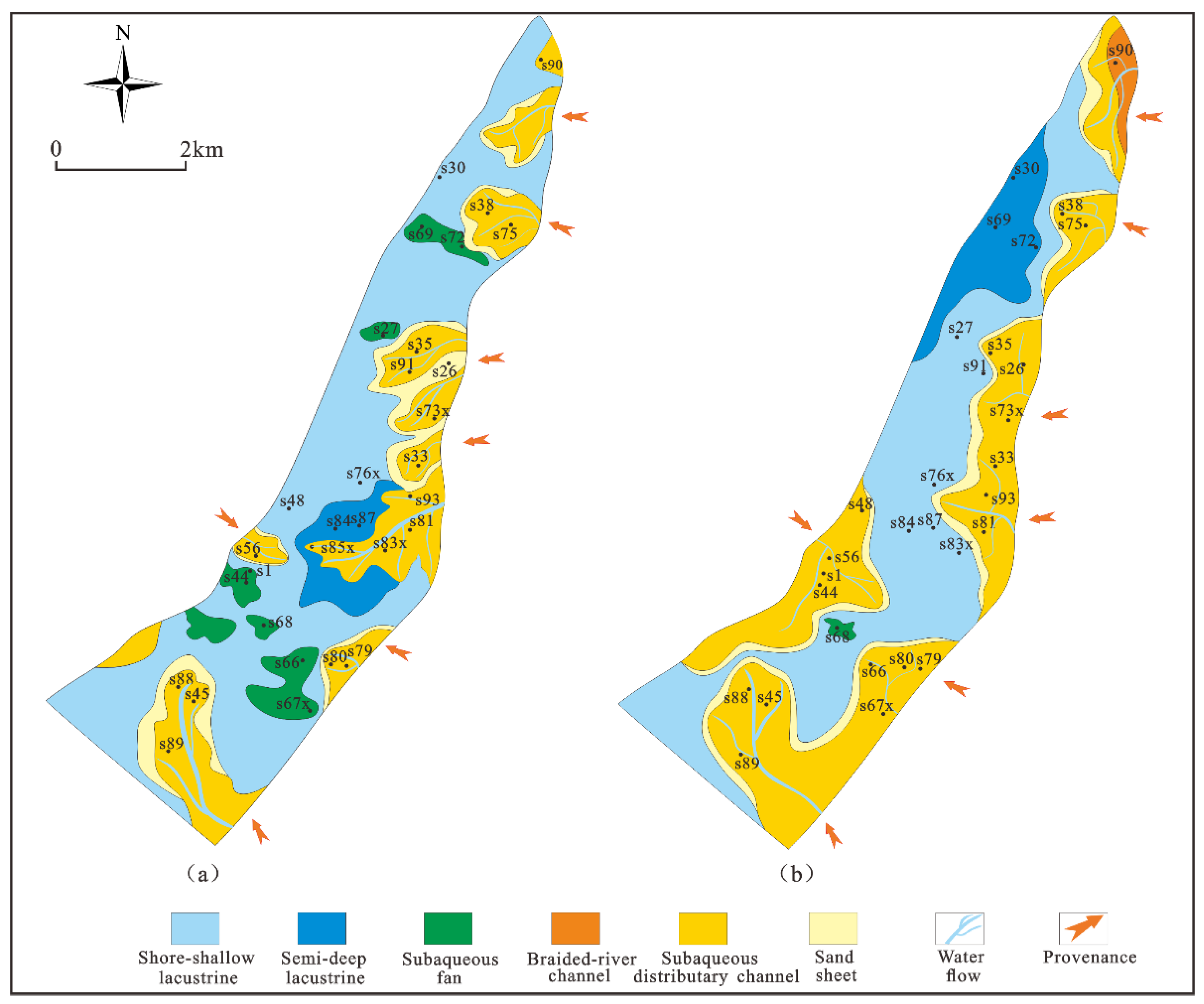
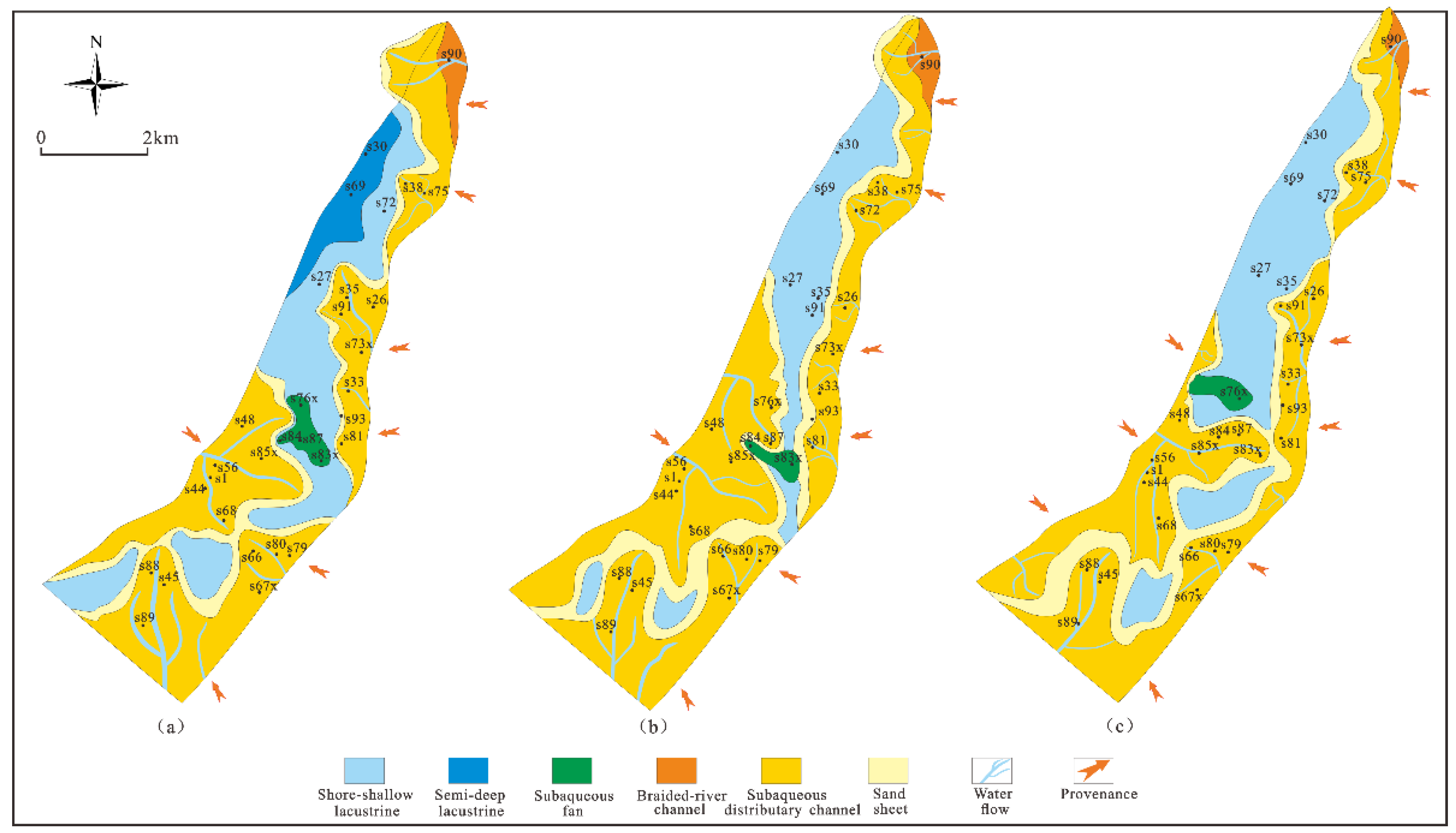
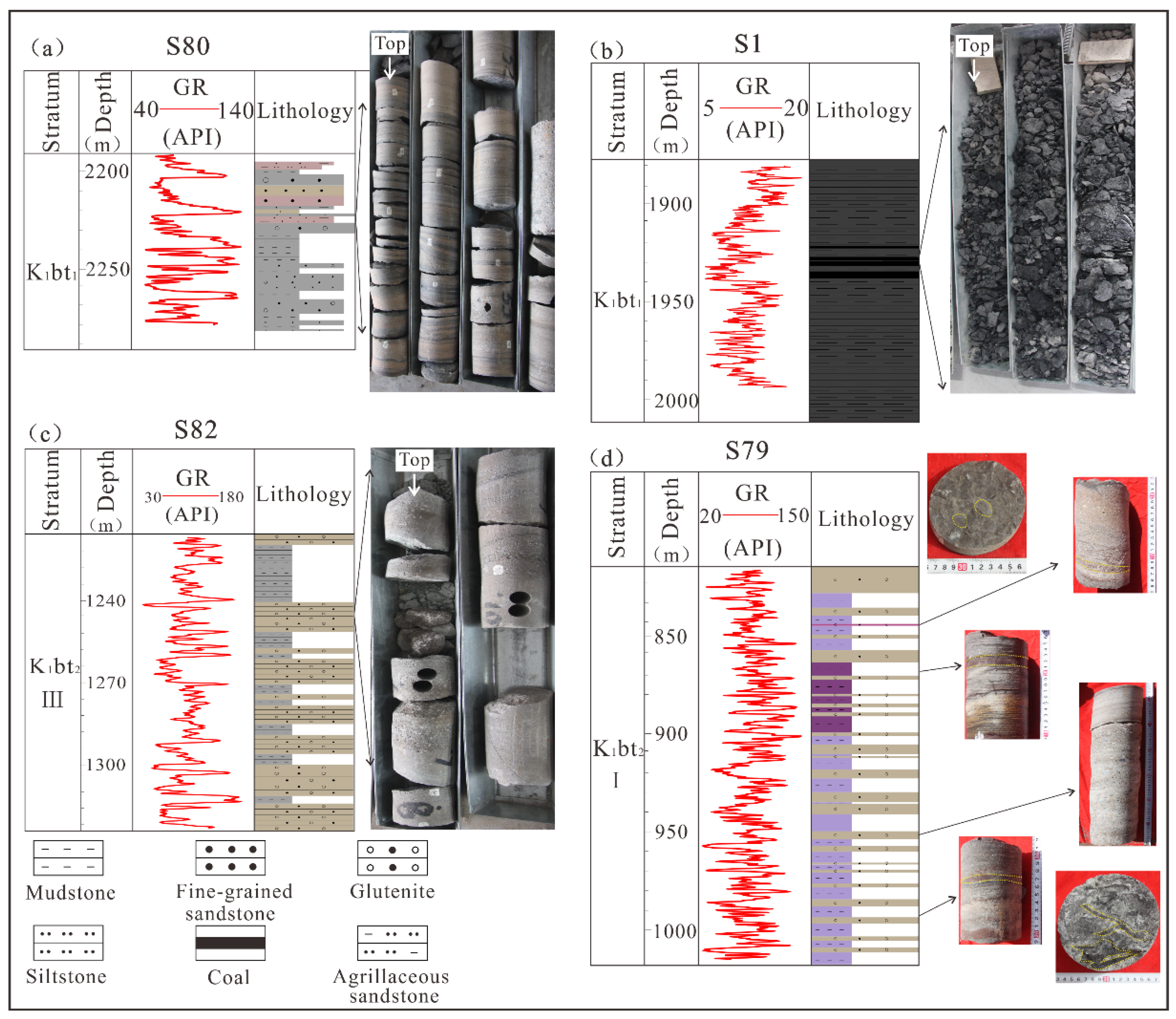
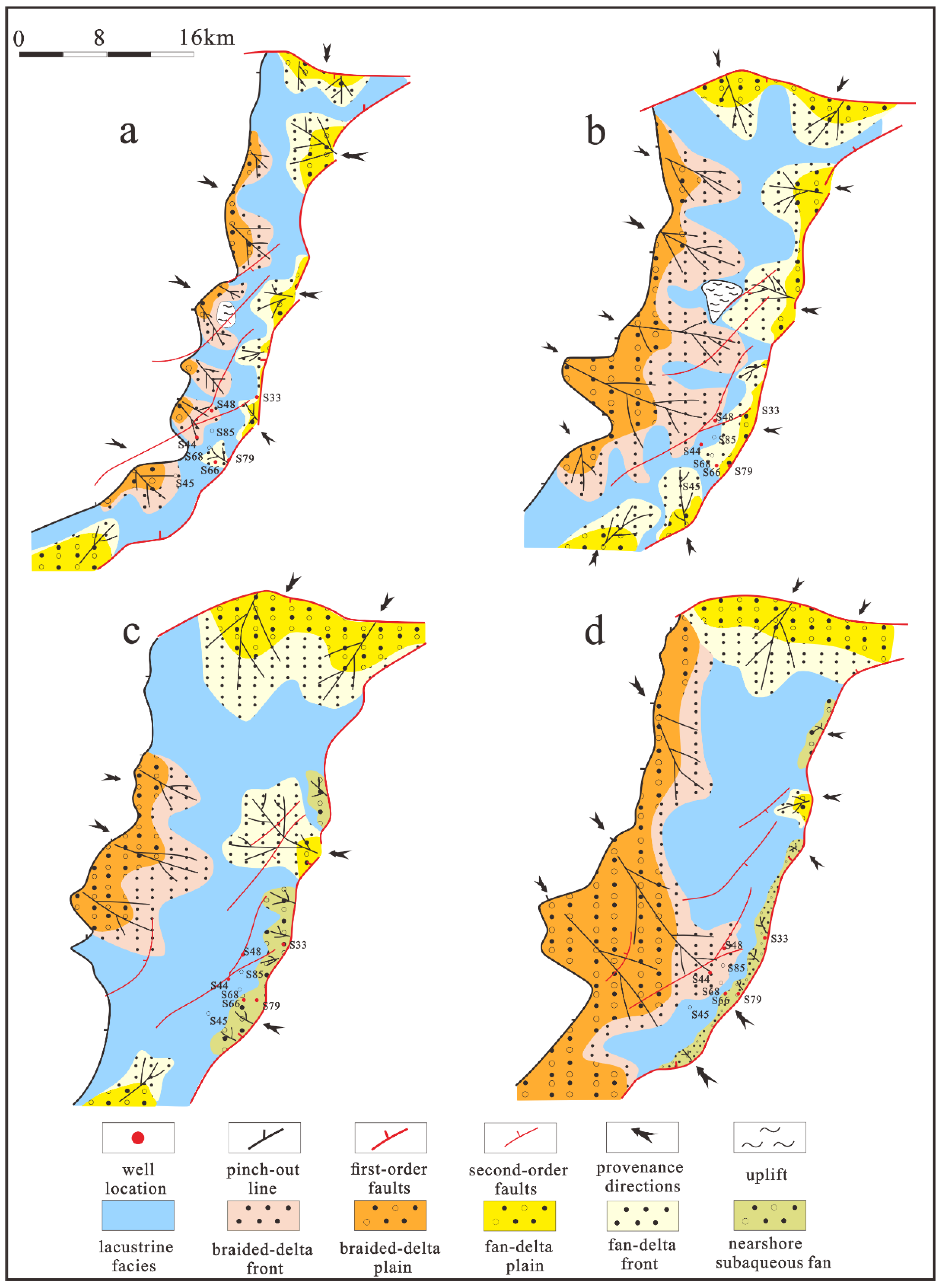
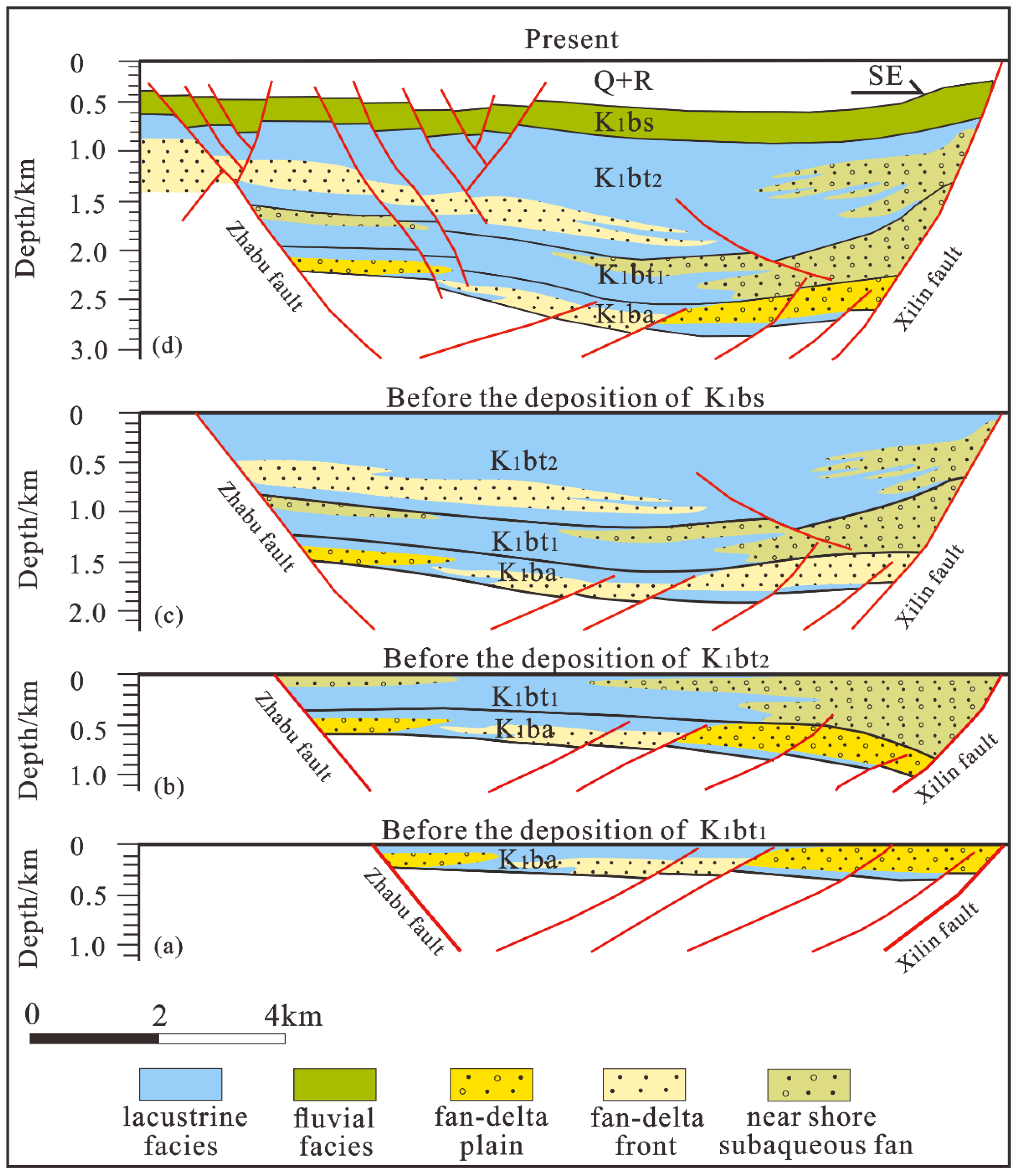

| Type | Subtype | Fine Type |
|---|---|---|
| Conglomerate lithofacies | A Structureless clast-supported conglomerate | A1 Mud-supported conglomerate |
| A2 Sand-supported conglomerate | ||
| B Grain-supported conglomerate | B1 Multi-order grain-supported conglomerate | |
| B2 Single-order grain-supported conglomerate | ||
| C Orientationally arranged conglomerate | C1 Imbricate granule conglomerate | |
| C2 Imbricate pebble conglomerate | ||
| D Graded conglomerate | D1 Graded sand–mud filling conglomerate | |
| D2 Graded sand-filling conglomerate | ||
| E Trough cross-bedded conglomerate | E1 Stratified mud–sand-supported conglomerate | |
| E2 Stratified sand-supported conglomerate | ||
| F Parallel-bedded conglomerate | F1 Parallel-bedded mud-filling granule conglomerate | |
| Sandstone lithofacies | G Structureless clast-supported sandstone | G1 Medium-coarse gravel sandstone |
| H Graded sandstone | H1 Normal-graded sandstone | |
| H2 Inverse-graded sandstone | ||
| I Cross-bedded sandstone | I1 Through cross medium-coarse sandstone | |
| I2 Wave cross fine-grained sandstone | ||
| J Lenticular-bedded sandstone | J1 Lenticular-bedded muddy fine-grained sandstone | |
| K Parallel-bedded sandstone | K1 Parallel-bedded fine-silty sandstone | |
| Mudstone lithofacies | L Mudstone | L1 Sandy mudstone |
| L2 Gray mudstone |
Publisher’s Note: MDPI stays neutral with regard to jurisdictional claims in published maps and institutional affiliations. |
© 2022 by the authors. Licensee MDPI, Basel, Switzerland. This article is an open access article distributed under the terms and conditions of the Creative Commons Attribution (CC BY) license (https://creativecommons.org/licenses/by/4.0/).
Share and Cite
Yan, B.; Yuan, H.; Shan, X.; Zhou, T.; Liu, S. Sedimentary Characteristics and Their Controlling Factors of Lower Cretaceous Fan Deltas in Saidong Sub-Sag of Saihantala Sag, Erlian Basin, Northeastern China. Energies 2022, 15, 8373. https://doi.org/10.3390/en15228373
Yan B, Yuan H, Shan X, Zhou T, Liu S. Sedimentary Characteristics and Their Controlling Factors of Lower Cretaceous Fan Deltas in Saidong Sub-Sag of Saihantala Sag, Erlian Basin, Northeastern China. Energies. 2022; 15(22):8373. https://doi.org/10.3390/en15228373
Chicago/Turabian StyleYan, Bo, Hongqi Yuan, Xuanlong Shan, Tianqi Zhou, and Shengfei Liu. 2022. "Sedimentary Characteristics and Their Controlling Factors of Lower Cretaceous Fan Deltas in Saidong Sub-Sag of Saihantala Sag, Erlian Basin, Northeastern China" Energies 15, no. 22: 8373. https://doi.org/10.3390/en15228373
APA StyleYan, B., Yuan, H., Shan, X., Zhou, T., & Liu, S. (2022). Sedimentary Characteristics and Their Controlling Factors of Lower Cretaceous Fan Deltas in Saidong Sub-Sag of Saihantala Sag, Erlian Basin, Northeastern China. Energies, 15(22), 8373. https://doi.org/10.3390/en15228373







